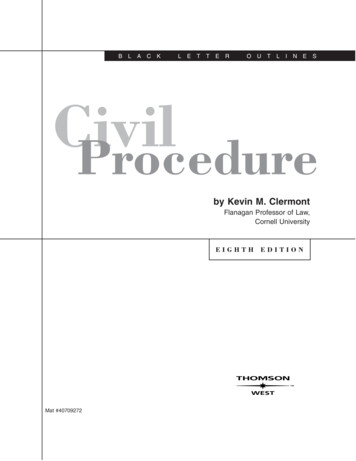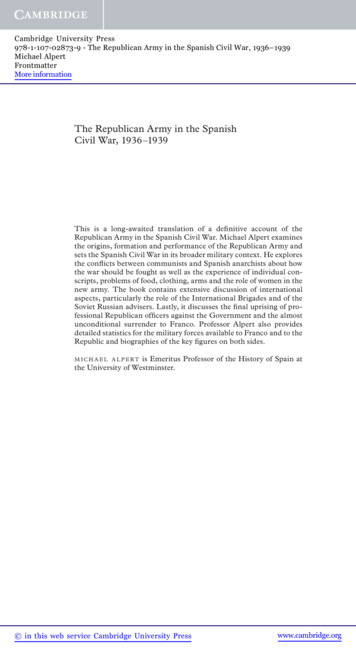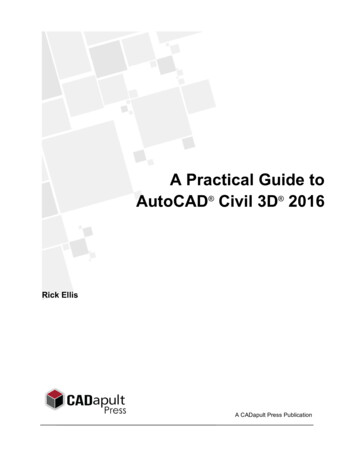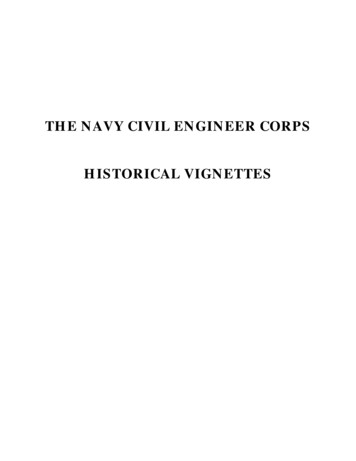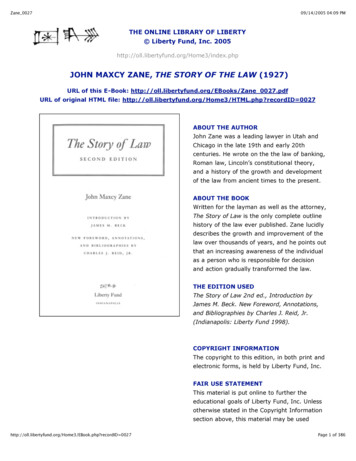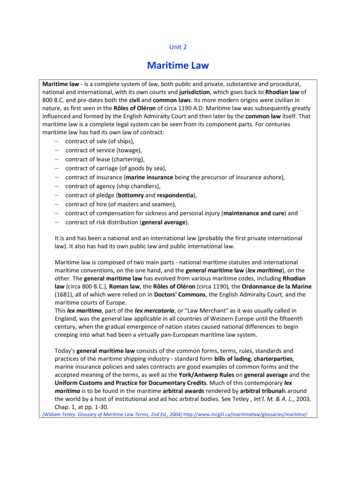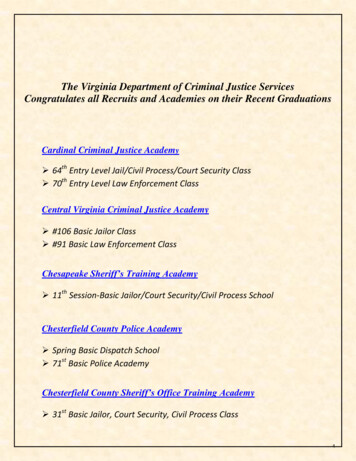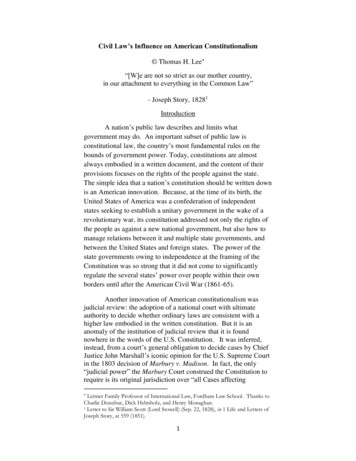
Transcription
Civil Law’s Influence on American Constitutionalism Thomas H. Lee “[W]e are not so strict as our mother country,in our attachment to everything in the Common Law”- Joseph Story, 18281IntroductionA nation’s public law describes and limits whatgovernment may do. An important subset of public law isconstitutional law, the country’s most fundamental rules on thebounds of government power. Today, constitutions are almostalways embodied in a written document, and the content of theirprovisions focuses on the rights of the people against the state.The simple idea that a nation’s constitution should be written downis an American innovation. Because, at the time of its birth, theUnited States of America was a confederation of independentstates seeking to establish a unitary government in the wake of arevolutionary war, its constitution addressed not only the rights ofthe people as against a new national government, but also how tomanage relations between it and multiple state governments, andbetween the United States and foreign states. The power of thestate governments owing to independence at the framing of theConstitution was so strong that it did not come to significantlyregulate the several states’ power over people within their ownborders until after the American Civil War (1861-65).Another innovation of American constitutionalism wasjudicial review: the adoption of a national court with ultimateauthority to decide whether ordinary laws are consistent with ahigher law embodied in the written constitution. But it is ananomaly of the institution of judicial review that it is foundnowhere in the words of the U.S. Constitution. It was inferred,instead, from a court’s general obligation to decide cases by ChiefJustice John Marshall’s iconic opinion for the U.S. Supreme Courtin the 1803 decision of Marbury v. Madison. In fact, the only“judicial power” the Marbury Court construed the Constitution torequire is its original jurisdiction over “all Cases affecting Leitner Family Professor of International Law, Fordham Law School. Thanks toCharlie Donahue, Dick Helmholz, and Henry Monaghan.1 Letter to Sir William Scott (Lord Stowell) (Sep. 22, 1828), in 1 Life and Letters ofJoseph Story, at 559 (1851).1
Ambassadors, public Ministers and Consul, and those in which aState shall be Party.” As I have described elsewhere, such casesimplicated sensitive foreign and interstate relations which earlyAmericans viewed as vital to the survival of their new nation. Thecentrality of judicial review to the Court’s role today makes usforget that the words of the Constitution suggest that resolvingdisputes affecting foreign ambassadors and among the Americanstates were perceived as the essential roles of the Court.2Although England had neither a written constitution nor asupreme court with judicial review,3 it was clearly the mostimportant source of American constitutionalism. The power ofjudges of the common law courts in the seventeenth and eighteenthcenturies in the face of royal prerogatives pioneered the modernrule of law. If not for the precedent of English common law, theU.S. Constitution and American-style judicial review would neverhave existed. These words by Chief Justice Taft in 1925 capturethe conventional wisdom:The language of the Constitution cannot be interpretedsafely except by reference to the common law and toBritish institutions as they were when the instrument wasframed and adopted. The statesmen and lawyers of theConvention who submitted it to the ratification of theConventions of the Thirteen States, were born and broughtup in the atmosphere of the common law, and thought andspoke in its vocabulary. They were familiar with otherforms of government, recent and ancient, and indicated intheir discussions earnest study and consideration of manyof them, but when they came to put their conclusions intothe form of fundamental law in a compact draft, theyexpressed them in terms of the common law, confident thatthey could be shortly and easily understood.4The Supreme Court-decision centric nature of Americanconstitutional law in the twentieth century has reinforced the sensethat American constitutionalism is “common lawSee id. The appellate jurisdiction of the Supreme Court, which is the primejurisdictional enabler of judicial review, is subject to Congressional control underthe Exceptions and Regulations Clause. “In all the other Cases,” other than thosereserved for the Supreme Court’s original jurisdiction, “the supreme Court shallhave appellate Jurisdiction, both as to Law and Fact, with such Exceptions andunder such Regulations as the Congress shall make.”3 It does now, although the UK Supreme Court does not have judicial review in thesame sense to review Parliamentary legislation for constitutionality.4 Ex parte Grossman, 267 U.S. 87, 108-109 (1925). .22
constitutionalism.”5 It is an approach to law that is inherentlyincremental and pragmatic with rare seismic shifts, akin to theorganic evolution of the common law generally.But things were not always so. The aim of this Article is toshow how the first century of U.S. constitutional jurisprudence andthe design and operations of the new national courts were alsoshaped by the other major Western legal tradition – the civil law.By “civil law tradition” I mean a way of thinking about law andlegal institutions rooted in Roman law and developed for the mostpart on the European continent in the twelfth to nineteenthcenturies.6 At the time of the American founding (i.e., beforecontinental European codification movements bore fruit), the civillaw tradition emphasized canonical texts as ultimate authority(including commentaries as well as formal laws), first principles oflaw, and rational investigative procedures for discovery of facts bya master or judge. In terms of substantive rules, the civil lawtradition was a “legal supermarket”7 as befit its continental scopeand ancient pedigree. It encompassed Roman imperial law and itsmythic republican antecedents, the internal civil law of manyEuropean polities, the canon law of the Roman Catholic Church,general commercial law,8 maritime and admiralty law, the law ofnations, and the law of federalism.9 The civil law tradition had asmall but important institutional footprint in late eighteenth centuryEngland: admiralty courts and church courts were staffed bycivilians, and the procedural rules of the Court of Chancery whichSee, e.g., David A. Strauss, The Living Constitution 36-49 (2010); ibid., CommonLaw Constitutional Interpretation, 63 U. Chi. L. Rev. 877 (1996).6 Experts in Roman law and civil law may object to this very broad use of thephrase “civil law tradition.” Strictly speaking, “civil law” (ius civile) refers to lawgoverning the individual relations of members of a state or commonwealth (civitas).Dig.1.1.1; Dig. 1.1.9 (G. Inst. 1). But I hope that they will understand why I haveused the phrase rather than more faithful ones like ius commune or ius utrumque or afull listing of Roman law, civil law, law of nations etc., to reach a modern audienceunfamiliar with more accurate nomenclature. Accord John Henry Merryman &Rogelio Perez-Perdomo, The Civil Law Tradition: An Introduction to the LegalSystems of Europe and Latin America (3d ed. 2007). For a sweeping account ofthe genesis of the entire Western legal tradition, see Harold J. Berman, Law andRevolution: The Formation of the Western Legal Tradition (1983).7 The phrase was used by Peter Stein in reference to the basic texts of Roman law.See Peter Stein, Roman Law in European History 2 (1999).8 For an illuminating recent article on this general commercial law, see EmilyKadens, The Myth of the Customary Law Merchant, 90 Tex. L. Rev. 1153 (2012).Kadens’ discussion of how local customs were more often accommodated ratherthan jettisoned in favor of universal norms mirrors the argument made infra PartII.C regarding the Dred Scott decision and slavery, about how artful civilians couldnavigate around presumptively universal principles to justify local customs.9 See infra Part I.B.1 discussion of conflict of laws and Bartolus. For a recentaccount of the origins of the idea and theory of American federalism, see Alison L.LaCroix, The Ideological Origins of American Federalism (2010).53
administered equity were essentially civilian, owing to theprevalence of bishops among the earliest Chancellors.Early American national jurists were attracted to this legalorder because participating in it could help integrate the agrarian,credit and maritime-trade hungry United States into the globaleconomy, and because it powerfully illuminated how to managerelations and commerce among the quasi-independent Americanstates while establishing the institutional primacy of the nationalcourts and uniform rules for national economic and socialintegration. Additionally, there was a strong desire to break awayfrom the English legal order in the public sphere—a revolutioninformed by veneration of Roman republican models, includingtheir laws.I emphasize at the start that my intent is not to deny thecentral importance of the common law tradition to Americanconstitutional law. Judicial power is the conditio sine qua non ofU.S. constitutionalism, and it was indubitably a common lawlegacy; generally, judges in civil law countries did not have thepower to make or shape law. (But civil-law judges of theAdmiralty court in England did have such power, and these civillaw courts were crucial models for the U.S. national courts becausemany of their early public law cases touched upon maritime andforeign affairs.) My intent, rather, is to suggest that appliedconstitutionalism in the first American century shows the existenceof two different mentalities or ways to think about public law andits application—a divergence attributable to the joint influence ofthe civil law and common law traditions.The civil law influence consisted of three elements: (1)substantive law, most importantly the civilian sub-disciplines ofthe law of nations, lex mercatoria, and maritime law; (2)civil lawprocedures, by contrast to the procedural norms of the commonlaw courts; and (3) a jurisprudential mindset favoring firstprinciples and equity over strict adherence to tradition andprecedent. Traces of these sorts of civilian influence were quitestrongly evident at the start of the Republic and during theantebellum years of national growth, climaxed in the postbellumperiod, vanished during the golden age of the American commonlaw judge, and resurfaced in the text-originalist jurisprudence ofthe late Justice Antonin Scalia—the Manchurian candidate of theforeign-law use wars.10 Adding these periods up, one realizes thatJustice Scalia, in his Tanner Lectures at Princeton University entitled “CommonLaw Courts in a Civil law System: The Role of United States Federal Courts inInterpreting the Constitution and Laws,” famously criticized the common lawmodel in American legal education and as a method of judging (March 8-9, 1995),104
it is the century or so (ca. 1890-1980) where civil law influencewas entirely eclipsed that is the anomaly and not the norm inAmerican constitutional jurisprudence. For its century, Americanconstitutionalism exhibited both common law and civil lawaccents. Indeed, the civilian spirit of American public law hasbecome obscured in large part because the apotheosis of theAmerican common law judge transformed constitutional law into acommon law subject.Grasping this historical diversity of legal influence putsAmerican constitutional law in a different, less nativist light. Italso helps us to understand similarities and differences between thecivil law and common law traditions generally, and what theymight mean for constitutional jurisprudence and practice today,both in the United States and in other countries. I think accountingfor civilian influence on the American constitutional order alsocasts doubt on the importance of precedents in public lawjurisprudence, i.e., the hegemony of the common law policy thatjudicial decisions should “stand by [preceding] decisions” (staredecisis); and the reluctance to borrow from outside the commonlaw tradition today.11 At the same time, we also may need torethink dismissals of modern modes of constitutional jurisprudencethat, like the pre-codification civil law tradition, privilege originalcanonical texts and presume logic-like certainty in first principles(formerly grounded in natural law12 or “well-established principlesof public law,”13 now in text or original meanings) as arriviste,unimaginative, or a Thermidorean reaction to the Warren Courtrights revolution.Many U.S. public lawyers (myself included) instinctivelyfeel that our constitutionalism is common law constitutionalism.14We read and teach cases and embrace eclectic decision-makingsensitive to changing contexts; 15 we do not assign canonicalavailable at scalia97.pdf. Thelectures, and rejoinders by leading academics, were published in Antonin Scalia, AMatter of Interpretation: Federal Courts and the Law (Amy Guttman, ed., 1998).11 As we shall see in the case study of the first civil procedure statute, the Americanfounding group made a conscious choice to reject familiar English and state laws infavor of untested civil law, rebutting the rejoinder that borrowing from outside thecommon law tradition occurred out of necessity in the absence of organic models.12 R.H. Helmholz, Natural Law in the Courts (2015).13 Pennoyer v. Neff, 95 U.S. 714, 722 (1878).14 David Strauss is the modern legal scholar most associated with this view, whichis likely shared by a majority of American constitutional law scholars. See David A.Strauss, The Living Constitution (2010); id., Common Law Constitution Interpretation,63 U. Chi. L. Rev. 877 (1996). See also Philip Hamburger, Law and Judicial Duty(2008).15 Common law constitutionalism is inherently eclectic. In deciding cases, judgescan consult text, history, policy, mo
that American constitutionalism is “common law 2 See id. The appellate jurisdiction of the Supreme Court, which is the prime jurisdictional enabler of judicial review, is subject to Congressional control under the Exceptions and Regulations Clause. “In all the other Cases,” other than those reserved for the Supreme Court’s original jurisdiction, “the supreme Court shall have .





